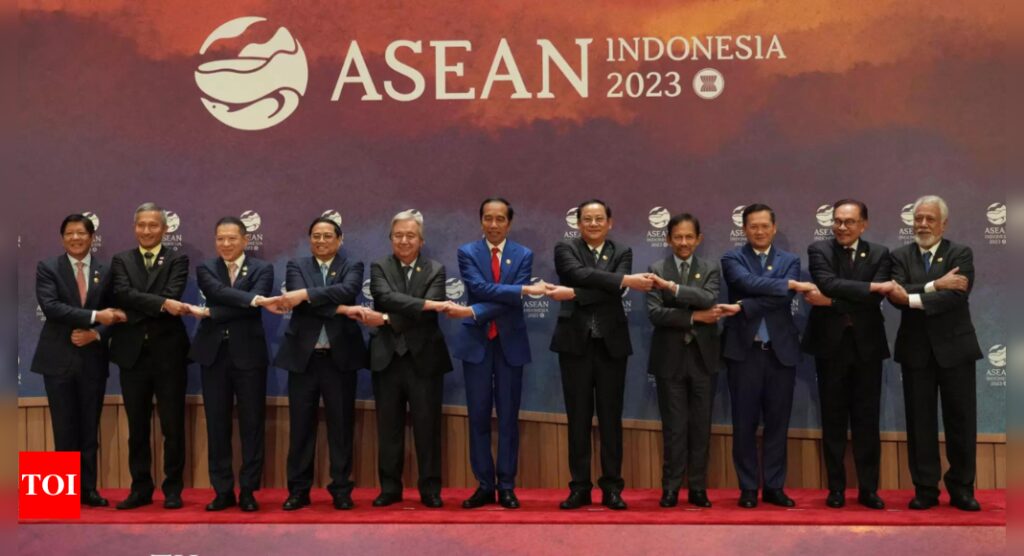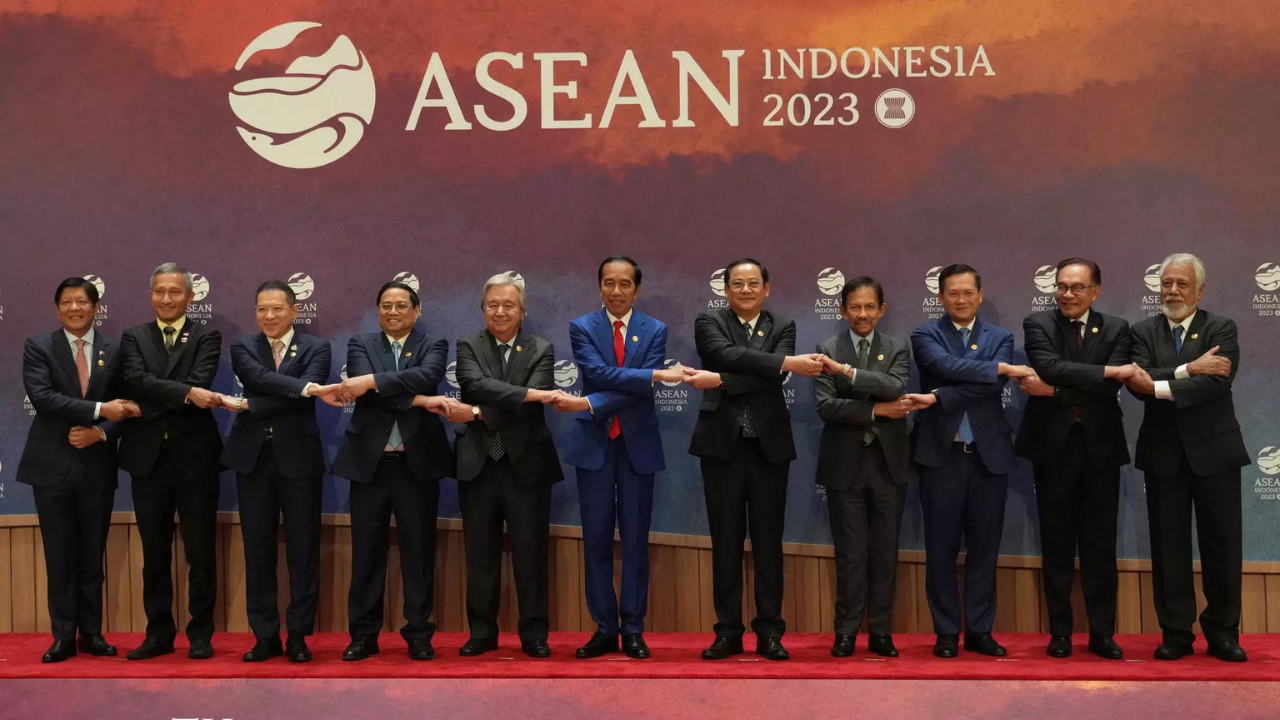[ad_1]
NEW DELHI: India and the 10-nation bloc Asean are likely to start their review exercise for the existing free trade agreement (FTA), including issues related to market access and making rules of origin comprehensive, an official said. The comprehensive rules of origin framework will help remove the scope for exporters from third countries to take advantage of concessional customs duties.
The FTA was signed in 2009 and implemented in January 2010, and the current chapter on rules of origin (RoO) is not “very detailed” and was based on value addition in products only, the official said.
As it was based on only value addition, “we do not know if a third country is utilising this agreement. But, we can not rule out that possibility. So, it is very important, and because of global value chains, we need to look at RoO in a very different manner because different sectors behave differently. It is an important chapter,” the official said.
The ‘rules of origin’ provision prescribes minimal processing that should happen in the FTA country, so that the final manufactured product may be called originating goods in that country.
Under this provision, a country that has inked an FTA with India cannot dump goods from some third country in the Indian market by just putting a label on it. It has to undertake a prescribed value addition in that product to export to India. Rules of origin norms help contain the dumping of goods.
“The existing agreement is in trade in goods, and in that, the core area is market access and rules of origin. So, we have stated that we should start talks on this first and lay out our aspirations and issues,” the official added.
In manufactured products, a domestic value addition of 35 per cent of FOB (the cost at the frontier of the exporting country) value was mandated. Another condition for availing concessional tariffs was that final processing is performed within the territory of the exporting country.
“We want to make rules of origin in the agreement more granular and product specific,” the official, who did not wish to be named, said, adding that in talks with Australia for expanding the existing trade pact, product-specific rules for about 6,000 tariff lines are being negotiated individually.
The value addition requirements are different for each product, and these values cannot be the same for agriculture and manufactured products.
While agricultural products are mostly grown and processed locally, manufacturing happens in global value chains.
For the review, the government has held stakeholder consultations with 7-8 sectors.
India and Asean have agreed to fast-track negotiations for the review of the existing agreement in goods between the two regions and conclude the talks in 2025.
It was agreed during the twentieth AEM (Asean Economic Ministers)-India Consultation meeting held at Semarang, Indonesia, in August.
The review of the Asean-India FTA (AITIGA) was a long-standing demand of Indian businesses, and the early commencement of the review would help in making the FTA trade facilitative and mutually beneficial, the commerce ministry has said.
Both regions have agreed to make the agreement more user-friendly, simple and trade-facilitative for businesses to increase trade and support sustainable and inclusive growth.
India is asking for a review of the agreement with an aim to eliminate barriers and misuse of the trade pact.
Members of the Asean include Brunei, Cambodia, Indonesia, Laos, Malaysia, Myanmar, the Philippines, Singapore, Thailand and Vietnam.
In general, such review exercises include implementation issues, rules of origin; verification process and release of consignments; customs procedures; further liberalisation of trade in goods; and sharing and exchange of trade data.
Trade experts have stated the review demand is there because India’s exports to Asean have been affected due to non-reciprocity in FTA concessions, non-tariff barriers, import regulations and quotas.
Concerns have also been raised about the routing of goods from third countries in India through Asean members by taking the duty advantages of the agreement. Asean has a much deeper economic engagement with China through the Asean China Trade and Goods Agreement.
During 2010-11, India’s exports to Asean increased to USD 25.7 billion from USD 18.11 billion in 2009-10. However, imports in 2010-11 rose to USD 30.6 billion from USD 25.8 billion in 2009-10.
Similarly, in 2022-23, India’s exports to Asean increased to USD 44 billion from USD 42.32 billion in 2021-22. However, imports jumped to USD 87.57 billion in 2022-23 against USD 68 billion in 2021-22.
The trade deficit has widened to USD 43.57 billion in the last fiscal from USD 25.76 billion in 2021-22. It was just USD 5 billion in 2010-11.
The FTA was signed in 2009 and implemented in January 2010, and the current chapter on rules of origin (RoO) is not “very detailed” and was based on value addition in products only, the official said.
As it was based on only value addition, “we do not know if a third country is utilising this agreement. But, we can not rule out that possibility. So, it is very important, and because of global value chains, we need to look at RoO in a very different manner because different sectors behave differently. It is an important chapter,” the official said.
The ‘rules of origin’ provision prescribes minimal processing that should happen in the FTA country, so that the final manufactured product may be called originating goods in that country.
Under this provision, a country that has inked an FTA with India cannot dump goods from some third country in the Indian market by just putting a label on it. It has to undertake a prescribed value addition in that product to export to India. Rules of origin norms help contain the dumping of goods.
“The existing agreement is in trade in goods, and in that, the core area is market access and rules of origin. So, we have stated that we should start talks on this first and lay out our aspirations and issues,” the official added.
In manufactured products, a domestic value addition of 35 per cent of FOB (the cost at the frontier of the exporting country) value was mandated. Another condition for availing concessional tariffs was that final processing is performed within the territory of the exporting country.
“We want to make rules of origin in the agreement more granular and product specific,” the official, who did not wish to be named, said, adding that in talks with Australia for expanding the existing trade pact, product-specific rules for about 6,000 tariff lines are being negotiated individually.
The value addition requirements are different for each product, and these values cannot be the same for agriculture and manufactured products.
While agricultural products are mostly grown and processed locally, manufacturing happens in global value chains.
For the review, the government has held stakeholder consultations with 7-8 sectors.
India and Asean have agreed to fast-track negotiations for the review of the existing agreement in goods between the two regions and conclude the talks in 2025.
It was agreed during the twentieth AEM (Asean Economic Ministers)-India Consultation meeting held at Semarang, Indonesia, in August.
The review of the Asean-India FTA (AITIGA) was a long-standing demand of Indian businesses, and the early commencement of the review would help in making the FTA trade facilitative and mutually beneficial, the commerce ministry has said.
Both regions have agreed to make the agreement more user-friendly, simple and trade-facilitative for businesses to increase trade and support sustainable and inclusive growth.
India is asking for a review of the agreement with an aim to eliminate barriers and misuse of the trade pact.
Members of the Asean include Brunei, Cambodia, Indonesia, Laos, Malaysia, Myanmar, the Philippines, Singapore, Thailand and Vietnam.
In general, such review exercises include implementation issues, rules of origin; verification process and release of consignments; customs procedures; further liberalisation of trade in goods; and sharing and exchange of trade data.
Trade experts have stated the review demand is there because India’s exports to Asean have been affected due to non-reciprocity in FTA concessions, non-tariff barriers, import regulations and quotas.
Concerns have also been raised about the routing of goods from third countries in India through Asean members by taking the duty advantages of the agreement. Asean has a much deeper economic engagement with China through the Asean China Trade and Goods Agreement.
During 2010-11, India’s exports to Asean increased to USD 25.7 billion from USD 18.11 billion in 2009-10. However, imports in 2010-11 rose to USD 30.6 billion from USD 25.8 billion in 2009-10.
Similarly, in 2022-23, India’s exports to Asean increased to USD 44 billion from USD 42.32 billion in 2021-22. However, imports jumped to USD 87.57 billion in 2022-23 against USD 68 billion in 2021-22.
The trade deficit has widened to USD 43.57 billion in the last fiscal from USD 25.76 billion in 2021-22. It was just USD 5 billion in 2010-11.
[ad_2]
Source link











More Stories
India’S Growth Forecast: S&P ups India’s FY’24 growth forecast to 6.4% on robust domestic momentum
India to remain fastest-growing major economy, but demand uneven: Poll
Jack Ma: Jack Ma gets back into business with ‘Ma’s Kitchen Food’